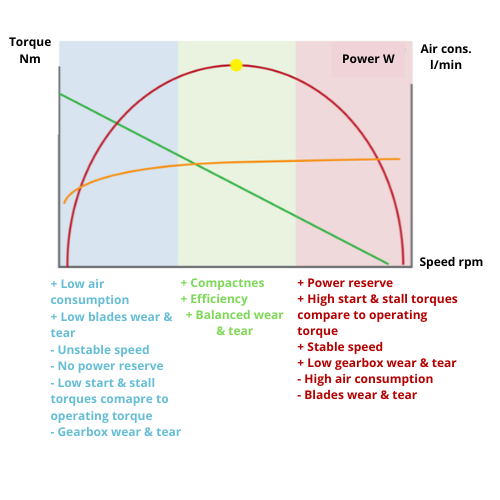You can ensure a high level of performance from your air motor for many years if it is used and maintained properly.
The good news is that maintaining an air motor is not difficult. Basically, there are two key elements to keep a close eye on: lubrication and filtration. Keep an eye on both of these, and your air motor will live a long and happy life. However, there are several steps you can take to maximize the life of your motor, and that starts with knowing how to choose it!
.png?width=500&name=Ajouter%20des%20lignes%20dans%20le%20corps%20du%20texte%20(4).png)
Before even talking about maintenance, lubrication etc., and in order to guarantee a long life for your air motor, you should choose it carefully. The positioning of the operating point required by the application to a motor in relation to its optimal operating point will determine advantages and disadvantages that must be taken into account when making the choice.
A mistake often made by future purchasers of an air motor is to focus on the mechanical performance of the motor rather than on the task to be performed by the motor. For example, can you say "I need a motor that can run at speed X" but do you know the torque it will have to handle? Or, on the other hand, can you say "I need a motor that can develop a torque of Y" but do you know how fast it will have to run at that torque?
So you need to take a step-by-step approach and ask yourself the right questions, in the following order
...start by asking yourself, "For what task do I need an air motor? " and from that answer, define - and refine - the mechanical questions.

-> To define which air motor is recommended for your application, follow the guide!
You can ensure a high level of performance from your air motor for many years if it is used and maintained properly.
The good news is that servicing and maintaining an air motor is not difficult. Basically, there are two key elements to keep a close eye on: lubrication and filtration. Monitoring these two aspects is the key to keeping your air motor running smoothly and ensuring optimum performance.
-> To find out how to perform maintenance on your air motor, it's here!
It is important to use the right oil to lubricate an air motor. A compressed air motor constantly generates cold due to the expansion of air in the pneumatic part. The oil must be liquid enough to lubricate even when the motor is operating at very low temperatures.
The viscosity and technical characteristics of the oil are therefore essential.
Using the wrong type of oil presents a real risk. Incomplete lubrication of all necessary areas will sooner or later lead to reduced performance - reduced starting speed or torque - and potential damage to the motor's vanes, or worse, to the cylinder (an expensive part to replace).
Good lubrication also helps reduce the possible effects of moisture inside the motor by preventing or minimizing the effects of corrosion.
If small dust or metal particles enter the air motor, they can damage the vanes and potentially degrade the cylinder surface. Installing a filter just before the air inlet point reduces the risk of particles entering the motor.
If they enter, the motor will lose speed, torque and therefore power. Replacing filters in an air motor is easy and costs very little, unlike replacing a cylinder, so keep an eye on the condition of your filters!
You must also be careful how you use the air motor. Ideally, it should be used regularly and for a period of time long enough for the oil to have time to lubricate the motor.
If the motor is not used regularly and long enough, make sure there is enough oil in it before storing it - this will counteract the risk of corrosion, especially in damp environments.
Also consider the weight of the load placed on the motor. If the load is too high, an air motor will stop before it can cause much damage. However, beware of strong vibrations, as these affect everything inside the motor - bearings, vanes and cylinder. Pneumatic motors used in an environment with high vibration have a shorter service life.
Follow these 5 simple steps and your air motor(s) will cope with your application over time.
For more information, feel free to download our complete guide!
+ 33 (0) 4 75 40 27 15
sales@modec.fr
ZI Sirius Quatre
80, allée René Higonnet
26760 Beaumont-lès-Valence, FRANCE
© Tous droits réservés - Modec - Création : ARKOD